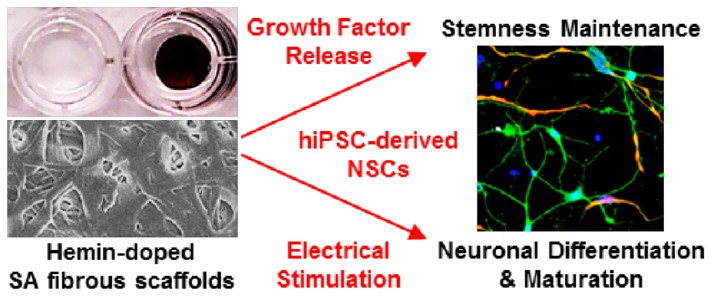|
血红素掺杂的血清蛋白纤维支架及神经组织工程应用
ACS Appl. Mater. Interfaces 2018, 10, 5305−5317 神经组织工程是支持神经修复和再生新疗法。为了重建神经元发育和成熟的复杂环境,理想的神经组织工程生物材料需要许多特性和能力,包括适当的生物和物理诱导,以及吸附和释放特定的生长因子。帝国理工大学Chia-Chen Hsu提出了基于静电纺丝牛血清白蛋白纤维支架的构建,用氯化血红素掺杂以赋予其高导电性,然后用重组蛋白和生长因子对其功能化以促进细胞附着和增殖。结果表明结合形貌,生物化学和电刺激在神经组织工程中就有应用潜力。氯化血红素掺杂的牛血清白蛋白支架有利于人诱导的多能干细胞的黏附,增殖和神经元分化,并且还能够结合并缓慢释放生长因子。与对照相比,结合电刺激对神经元的成熟产生积极影响,神经元显示出更多的神经突分支。通过促进人诱导的多能干细胞增殖,分化和神经突分支,氯化血红素掺杂的牛血清白蛋白纤维支架在神经再生工程中具有广泛的应用价值。 Neural tissue engineering is a new therapy that supports nerve repair and regeneration. In order to reconstruct the complex environment of neuronal development and maturation, a ideal neural tissue engineering biomaterials require many properties and capabilities, including proper biological and physical induction, as well as adsorption and release of specific growth factors. Chia-Chen Hsu of Imperial College London proposed the construction based on bovine serum albumin fiber electrospun scaffolds, which were doped with hemin to improve conductivity. And then combining recombinant proteins and growth factors to promote cell attachment and proliferation. The potential of combined morphology, biochemistry and electrical stimulation in neural tissue engineering applications has been demonstrated. Hemin-doped bovine serum albumin fiber scaffolds facilitate adhesion, proliferation and neuronal differentiation of human induced pluripotent stem cells (hiPSCs), and are able to bind and slowly release growth factors. It has a positive effect on neuronal maturation, and the neurons show more neurite outgrowth than controls by combined with electrical stimulation. The hemin-doped serum albumin fiber scaffold has wide application value in nerve regeneration engineering by promoting hiPSCs proliferation, differentiation and neurite branching. (张守燕)
|
